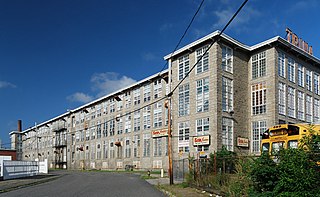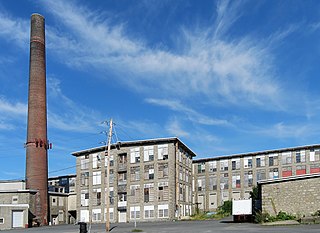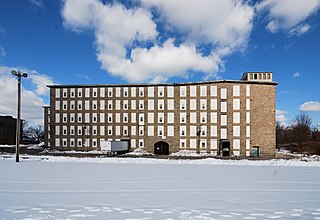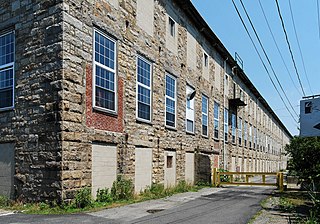
For much of its history, the city of Fall River, Massachusetts has been defined by the rise and fall of its cotton textile industry. From its beginnings as a rural outpost of the Plymouth Colony, the city grew to become the largest textile producing center in the United States during the 19th century, with over one hundred mills in operation by 1920. Even with the demise of local textile productions during the 20th century, there remains a lasting legacy of its impact on the city.

The American Printing Company, located in Fall River, Massachusetts grew to become the largest producer of printed cotton cloth in the United States by the early 20th Century. The company grew as an offshoot of the Fall River Iron Works, established in 1821 by Colonel Richard Borden and Major Bradford Durfee. The American Print Works was established in 1835 by Holder Borden. It employed several thousand workers at its peak during World War I.

The Border City Mill No. 2 is a historic cotton textile mill at One Weaver Street in Fall River, Massachusetts. Built in 1873, it is the largest surviving element of the once-sprawling Border City Mill complex. It was designed by Josiah Brown, a prominent local designer of mills, and is one of the city's few brick mills. It was listed on the National Register of Historic Places in 1990. It was converted into residences in the 1980s.

Chace Mills is a historic textile mill complex on Lewiston and Salem Streets in Fall River, Massachusetts. Built in 1872, it is one of the city's most visible historic mills, with a particularly fine Italianate stair tower. The complex was added to the National Register of Historic Places in 1983.

The Lower Highlands Historic District encompasses one of the oldest residential areas of Fall River, Massachusetts. The district is roughly bounded by Cherry, Main, Winter, and Bank Streets, and is located just east of the Downtown Fall River Historic District and directly south of the Highlands Historic District. This area was settled by 1810, has architecture tracing the city's growth as a major industrial center. The historic district was added to the National Register of Historic Places in 1984.

The Algonquin Printing Co. is a historic industrial complex at 1 Middle Street, off Bay Street in Fall River, Massachusetts. Developed beginning in 1891, it was the last 19th-century printing operation to be established in the city. The surviving main building was built in 1902, and the company operated on this site until 1941. It was listed on the National Register of Historic Places in 1983.

Durfee Mills is an historic textile mill complex located at 359-479 Pleasant Street in Fall River, Massachusetts, USA. Developed between 1866 and 1904, it was during its period of development the city's largest and architecturally finest mill complex. Along with the adjacent Union Mills, it is occupied by numerous retail businesses and a restaurant, and is known as the Durfee-Union Mills. The complex was listed on the National Register of Historic Places in 1983.

Union Mills is a historic textile mill complex located on Pleasant Street in Fall River, Massachusetts.

Sagamore Mills No. 1 and No. 3 are two historic textile mills on Ace Street in Fall River, Massachusetts. Built in 1888 and 1908, they form part of one of the city's single largest textile operations of the late 19th century. Mills No. 1 and 3 were added to the National Register of Historic Places in 1983, with a separate listing for Mill No. 2, located nearby on North Main Street.

Sagamore Mill No. 2 is an historic textile mill located at 1822 N. Main Street in Fall River, Massachusetts. Built in 1881, it is the oldest surviving mill of three built by the Sagamore Mill Company, one of Fall River's largest textile operations. The mill complex was added to the National Register of Historic Places in 1983.

Barnard Mills is an historic mill at 641-657 Quarry Street in Fall River, Massachusetts. Developed beginning in 1874, it was the first mill to use ring spinners instead of mule spinners, and was a major local employer until its closure in 1939. The complex has been redeveloped as a commercial retail space called Tower Mill. The mill was added to the National Register of Historic Places in 1983.

Charlton Mill is a historic textile mill at 109 Howe Street in Fall River, Massachusetts. Built in 1911, it is the last of the city's stone mill buildings to be built, and the first to feature the dual sources of steam and electrical power. The mill was added to the National Register of Historic Places in 1983.

Crescent Mill, later Merchant Mill No. 3, is an historic cotton textile mill located at 54 Front Street in Fall River, Massachusetts. Built in 1872 during an industrial construction boom, it is one of the city's finest examples of Italianate mill architecture. The building was added to the National Register of Historic Places in 1983. It is now used for other light industrial purposes.

Flint Mills is a historic textile mill complex located on Alden Street in Fall River, Massachusetts, near the banks of the Quequechan River. The company was founded in 1872 and named in honor of John D. Flint, who served as its first president. The original 1872 mill burned in 1882, and was rebuilt in 1883. The complex was later expanded with a second mill and large addition in 1909. The site also contains a detached granite mill office building. The section of Fall River surrounding the mill became known as "Flint Village". The site was added to the National Register of Historic Places in 1983.

King Philip Mills is an historic cotton mill complex located at 372 Kilburn Street in Fall River, Massachusetts. Developed between 1871 and 1892, it was historically one of the city's largest mills, and its building inventory is still largely complete. The complex was added to the National Register of Historic Places in 1983.

Cornell Mills is an historic cotton textile mill on Alden Street in Fall River, Massachusetts. Built in 1890, it is a well-preserved example of late 19th-century industrial mill architecture in stone. The mill complex was added to the National Register of Historic Places in 1983. On February 26, 2016, a developer has bought the property with the intent to convert the mill into middle-class residential housing.

Quequechan Valley Mills Historic District is a historic district located on Quequechan, Jefferson, and Stevens Streets between Interstate-195 and Denver Street in Fall River, Massachusetts. The district was added to the National Register of Historic Places in 1983.

Fall River Bleachery is an historic textile bleachery on Jefferson Street in Fall River, Massachusetts.

Granite Mills are two historic cotton textile mills located on Bedford Street in Fall River, Massachusetts, consisting of Granite Mill No. 2 and Granite Mill No. 3. The site was determined eligible to be listed on the National Register of Historic Places in 1983, but was omitted due to owner's objection.






















